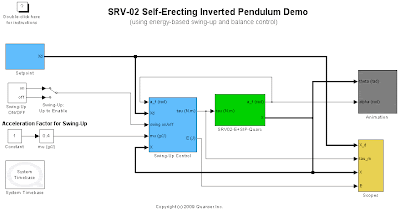One of many challenges engineering educators face is the speed with which technology evolves. To prepare students for the real world, professors need to teach them fundamentals as well as expose them to the hottest technology. That’s why Quanser's engineers work hard on enhancing our staple products, such as linear and rotary motion experiments, as well as bringing new innovative plants to engineering labs.
In 2009 we introduced several new systems – a more compact and portable Shake Table I-40, an innovative HD^2 haptic device, and the very popular Mechatronic Controls Collection.
The year 2010 is going to be equally exciting – watch for new solutions that are more compact and energy-efficient, and give you more flexibility, while saving time and money. Let’s have a peek into the engineering “gadget room”:
Control Design Software: The Engine for Engineering Innovations
The heart of all Quanser systems is QUARC, our real-time control software. Version 2.0 released in December 2009 brings many unique features that we've mentioned on our blog. The engineers are now adding even more great features and capabilities, such as support of Windows 7, new features in the visualization and much more for release in April. In the meantime, take QUARC for a test drive with our virtual plant. Request a free demo today.
QUARC is also the heart of a Challenging Environment  Assessment Laboratory (CEAL) simulator, one of the most advanced rehabilitation research facilities in the world. Our engineers are gearing up for final stages of the project, a collaboration with the Toronto Rehab Institute.
Assessment Laboratory (CEAL) simulator, one of the most advanced rehabilitation research facilities in the world. Our engineers are gearing up for final stages of the project, a collaboration with the Toronto Rehab Institute.
The CEAL facilities consist of a large, one-of-a-kind, 6-degree of freedom, hydraulic motion platform.
Powerful Amplifier
A lot of new developments are happening in the Hardware-In-The-Loop Accessories department: in spring watch for a more compact and portable solution to power amplification: VoltPAQ. This new generation of power amplifiers can be used to drive multiple actuators and will be especially useful for multi-DOF experiments, such as a 3 DOF Helicopter.
Prevailing DAQ
In February watch for the release of QPID, a new generation of PCI and PCIe data acquisition boards, that bring more  functionality and features, combined with better real-time performance. Please note the Q8 H.I.L. board will be phased out as this more powerful solution comes in.
functionality and features, combined with better real-time performance. Please note the Q8 H.I.L. board will be phased out as this more powerful solution comes in.
QPID, Quanser's new data acquisition board
Portable DAQ
Slated for release in spring is yet another novel data acquisition board - the Q8-USB. With this portable technology you can interface to hardware conveniently through a USB connection while maintaining a hard real-time performance. Where the full functionality of Q8-USB is not needed, customers have the flexibility to choose a Q2-USB board that we are currently developing.
USB Driven
USB connectivity will be also a part of the improvement of some existing systems: HD^2 haptic device and the Hexapod, the 6 DOF motion platform from Mechatronic Controls Collection will soon be USB driven. For the Hexapod we will also be upgrading its power capabilities, making it move faster, with more force.
Unmanned Systems and Robots
The big focus in 2010 will be on unmanned systems and robotics. We have already introduced the Unmanned Vehicle Systems Lab to perform multi-vehicle missions with unmanned aerial and ground vehicles indoors. This year we are enhancing the multi-vehicle capabilities, like flying three Qballs together.
Quanser's Unmanned Ground Vehicle was developed for outdoor  UVS research. The remotely controlled golf cart-based system can be integrated with other unmanned vehicles for more complex collaborative control.
UVS research. The remotely controlled golf cart-based system can be integrated with other unmanned vehicles for more complex collaborative control.
Quanser's remotly controlled UGV for research of unmanned systems
In the area of robotics we plan to expand the collection of robots with open architecture control. The popular high-performance Denso robots will soon have real-time control capabilities through QUARC, joining other robots like KUKA, CRS, and Mitsubishi that QUARC can work with.
Despite the long list, we still haven't captured everything. So stay tuned for more news about what we are engineering in our "gadget room”.





